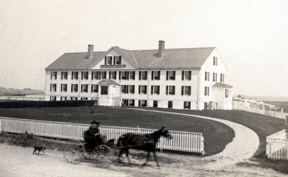Our Island Home History
Frances Ruley Karttunen is a twelfth-generation descendant of Nantucket’s first English settlers and a friend of FoOIH. She has written extensively about Nantucket’s history and this excerpt from her book, Nantucket – Places and People 4, chronicles some history of the building and its occupants from the 1820’s till the 1980’s when the current facility was built. We thank her for allowing us to sample this piece.

While the last resting place of some of the residents of the Asylum is in Quaise, the building in which others resided in life is now located in town. On the left side of Orange Street as one proceeds outbound from the center, stands Landmark House. Now housing an assisted-living community, it was previously Our Island Home.
Before the prominent old building was Our Island Home, it had been Nantucket’s Town and County Asylum. The word “asylum” invites the modifier “insane,” but Nantucket’s Asylum housed the indigent. A person might be unable to support himself by reason of mental incapacity, but some elderly people found their way to the Asylum simply because they had outlived anyone who could care for them at home. Others ended up there after falling ill far from home. Such was the plight of a number of unfortunate Pacific Islanders who came to Nantucket on whaling ships and breathed their last in Nantucket’s Asylum.
Like so many historic Nantucket houses, the Orange Street building has been moved from place to place. It began its service in Quaise as part of an evolving social experiment.
The Town of Nantucket had built a workhouse on land between Vestal Street and Upper Main Street in 1773. Initially, residence there was not compulsory for people receiving municipal aid, but then things changed. Nantucket historian Obed Macy wrote, “Somewhere about 1796 it was concluded that all who wanted supplies from the town must come and reside at the so-called workhouse. By midwinter, this plan came near to starving some of the poor to death, for rather than take their families and go to the workhouse, they went hungry.” In 1805, the town built a jail on the site of the old workhouse, necessitating some other living arrangement for the indigent.
It took until 1822 for the town to come up with a solution. The poor would be moved to a healthful rural setting where they would raise their own food. According to the town’s selectmen, the Mark Coffin farm in Quaise just fit the bill. Obed Macy did not approve of this plan. He objected that move would isolate the poor from the community and their relatives, that transporting people and supplies out from the farm would be expensive, and that the people who would be sent to Quaise were, in any case, too debilitated to do farm work. At the very least, wrote Macy, the town should consider buying one of several smaller farms that were available at the time.
The town meeting ignored those considerations and went ahead with the plan. Coffin’s farm was purchased and four buildings were erected on it. Ultimately, one of them, built-in 1826, was moved to town and re-erected right next to the jail off Vestal Street to serve as Nantucket’s House of Correction.
The Quaise Asylum functioned from the 1820s to 1844, when a fire broke out on a snowbound winter night. The alarm bell was tolled and tolled, but the fire had burned itself out before firefighters could make their way to Quaise. Of the fifty-nine inmates of the Asylum, ten perished in the blaze. One of the survivors, Lucretia Brackett, was credited with saving the lives of several of the others by dragging them to windows, where rescuers stood ready with ladders. Another, Lydia Bowen, rescued her child from the fire, but then re-entered the burning building and perished.
The fire victims were buried in a nearby field, and the next year, 1845, the town invested nearly $2000 (equivalent to $62,000 in 2013 dollars) in a fine new building for the Quaise Asylum. Nonetheless, Obed Macy’s predictions had proven true. Isolation of the poor had been fatal to ten of them, and provisioning the survivors so far from town was impractical. In less than a decade, the new building was moved in sections from Quaise to the present location on Orange Street to serve as a place “for the care of the needy, mentally ill, homeless and diseased.” The residents were still expected to raise their own vegetables, and they did so on the nearby land known to this day as Poverty Point. The 1854 move cost the town $7500 (almost $240,000 2013 dollars).
Hardly had the facility gotten up and running on Orange Street when two significant deaths took place: on November 25, 1854, Abram Quary, “the First that died in the Asylum in Town, aged 82 years, 10 months”; and then on January 12, 1855, Dorcas Honorable, “aged 72 years, 8 months, 12 days.” They were the very last of Nantucket’s dwindling list of “last Indians.”
The community’s attitude toward those who were unable to live on their own continued to evolve. Obed Macy observed that the “town poor” had been miserably provided for back in the 1790s. At the beginning of the 1820s, as the town meeting debated moving the out of town, Macy wrote, “It is represented that they are nasty and wicked.” By the time the Asylum was brought back to town, attitudes had softened. Now the Asylum existed to provide care for the incapacitated. Finally, in 1905, the town’s board of overseers renamed the Asylum “Our Island Home” and defined its mission as to provide “tender loving care of the infirm aged,” a role fulfilled with grace and real beauty to this day.
After the nursing-home residents moved into a new building in 1981 and took the name Our Island Home with them, a five-year effort to transform the old Asylum building into affordable housing for Nantucket’s independent seniors came to fruition, and Landmark House opened. So ended the odyssey of a building that began its existence miles away out in Quaise as part of a distinctly punitive institution.

